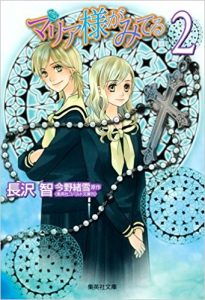 1. Introduction
1. Introduction
In the early 20th century, girls’ literature in Japan began as an offshoot of the relatively new concept of educating (primarily upper-class) girls in sex-segregated Catholic schools. These young women were encouraged to focus their passion on platonic romantic relationships with admired older schoolmates, as a non-sexual and innocuous alternative to affairs with young men outside formal arrangements of courtship and marriage. We’ve looked at some of this literature previously: Yoshiya Nobuko’s foundational series Yaneura no Nishoujo, and Kawabata Yasunari and Nakazato Tsuneko’s Otome no Minato, among them. Both of these stories got their start in girl’s magazines of the age which also published letters by young women telling breathless tales of attraction and emotional intimacy between themselves and these admirable older sisters. The setting of these letters and the literature they inspired endured through the 20th century as seeds of influential manga series such as Sakura Namiki and Shiroi Heya no Futari eventually blossoming into the genre we know of as Yuri.
As the 20th century headed to a close, this same hothouse setting was used for a story in Shueisha’s Cobalt magazine, a magazine marketed to young women. The magazine featured stories of fantasy and romance (and romantic fantasies) and, in 1997, it ran a story about a young woman who felt out of place at one of these girls-only Catholic schools, seeing and being entranced by a beautiful upperclassman. This was met by a unexpected wave of sentimental approval from a late 20th-century female audience and so, in 1998, Maria-sama ga Miteru by Konno Oyuki began publication with illustrations by Hibiki Reine. Other one-shot manga shorts, illustrated by Hibiki Reine were published in Cobalt, in 2003-2004. The light novel series was successful enough to continue at the pace of several volumes a year, with additional short stories, for 15 years. A manga adaptation by Nagasawa Satoru began in Shueisha’s Margaret magazine in 2003, targeting the same teen audience the novelizations had in Cobalt. The manga, which underwent several hiatuses and magazine changes wrapped up at 9 volumes in 2010. In 2003, after 14 volumes of the novel series had been published, a television anime series was announced. In 2004, (after the 15th novel had been released) the television anime made it’s debut. The anime ran for 3 seasons, and a fourth season was released as a series of OVAs.
Following up the release of the anime, from 2004 through 2010, 14 Drama CDs voiced by the anime cast were recorded, which dramatized the novels through the 11th novel, Parasol wo Sagshite, and 12 Special/Premium CDs with cast talk tracks and dramatizations of various stories starring the guests, (as well as a few rather silly new stories) were released. All told, the voice dramas took the audience up to “Kibara Panic,” a short from the 22nd novel, Kibara Millefueille.
Yuri fandom was more than ready. We jokingly described the series as “Catholic schoolgirls doing nothing,” but the relationships are so emotional and so intimate that we could clearly see that the idealized platonic romance of the early 20th century Catholic schoolgirl was here to stay. And it is though these relationships that we’ll be taking a look at the series, and it’s legacy today.
 2. Sisterhood and Sœur
2. Sisterhood and Sœur
At the very heart of Maria-sama ga Miteru is the “sœur” system at Lillian Girl’s Academy. This idealized kinship system is an iteration of traditional Japanese sempai/kouhai relationships, in which an older student (or employee, club member, etc) provides guidance and mentorship to a younger or newer person. These relationships may (but not always do) last for many or all years of a person’s life, with attendant formalities between people even decades afterwards. This fictitious sœur system incorporates the platonic romance of early 20th century girls’ literature, which is also called “Class S” literature, in which S may have stood for shoujo, schöne, or even for escape. It seems reasonable to also consider that “sister” might have been on that list. English was a new (and therefore exotic,) language being taught by these European teachers in Catholic schools, along with French. Sœur is French for “sister”. By the time the third book of the series, Ibara no Mori, rolls around, it becomes pretty obvious that Konno-sensei is well grounded in Class S literary antecedents and is comfortable drawing on the early literature for inspiration and reference. As so we will return the favor by drawing on it for inference, as well.
The portrayal of sisterhood-relationships through the sœur system are varied. In fact, by the end of the series, the author goes to some length to find new, and occasionally amusing, ways to establish that relationship above, beyond and including familial bonds of sisterhood, with both positive and negative expressions of that relationship. It also offers up an opportunity for fans of the series to see the rich, complex inner lives of young women, and the many layers of relationships outside familial and romantic pairings. This last is critical, as fandom generally has a great deal of difficulty recognizing that women have many kinds of affectionate bonds, preferring the unsubtle idea that any form of affection means that a couple is romantically (or sexually) involved. It’s worth, therefore, taking a look at a few of those layered relationships.
While the sœur couples in Maria-sama ga Miteru exist thoughout the school, especially within clubs and teams which have their own natural hierarchies, the primary lens through which we see the system expressed is the relationships of the Yamayurikai, the school’s Student Council. In this group, the sœur fall under one of three Rose “families,” in accordance with the position maintained by the Grande Sœur: Rosa Chinensis, Rosa Gigantia or Rosa Foetida.
Because we spend the most time with members of each of these families, it seems natural to look at the relationships within them. We’ll begin with the Red Rose Family, as this provides us the vehicle for protagonist Yumi’s involvement with the sœur system.
Rosa Chinensis Family
The Red Rose family is known primarily for it’s hard work, competence and natural busy-bodiness. If a Red Rose thinks they can “fix” a situation, they will not hesitate to get involved.
Yumi and Sachiko
Our first encounter with Yumi is as she hears of a classmate who has become an older girl’s “petite sœur.” Yumi is our vessel on this voyage through the arcane traditions of a school founded in the middle of the Class S age. Fukuzawa Yumi is honest and goodhearted, but not, apparently, special. And yet, we watch this “average” girl become involved with – but not overwhelmed by – the elites of the school, the Student Council. And most especially with the object of her own admiration, Ogasawara Sachiko.
Sachiko is presented as a modern-day version of Shiroi Heya no Futari‘s Simone; a classic Japanese beauty with a high-strung and temperamental, even volatile. personality. Sachiko is admired and feared rather than loved, by her fellow students. Yumi, likewise reflects a less-naive, but no less energetic and cheerful version of Shiroi Heya‘s Resine. The lack of naivete is not accidental. Yumi is never naive, she is shockingly grounded in a world inhabited by wealthy and, we are meant to assume, unworldly, students. Yumi’s cheerful, yet average, personality makes her almost instantly relatable; but its her quiet strength and her refusal to bend under the weight of Sachiko’s strong personality that makes her likeable. As the series goes on, we can see that Yumi is quietly shaping Sachiko’s experience. Tantrums disappear, as Yumi’s perseverance works through problems without need for them. Sachiko learns to rely on her younger sister in a way that she has never felt able to before. And in doing this, Yumi makes two people deeply uncomfortable.
Youko and Touko
Mizuno Youko picks Sachiko as sœur for several reasons, as we learn in Answer that the over-competent and willful girl seems like a fun challenge to her. She also feels bad for Sachiko, who is over-burdened with obligations. This sense of challenge and pity set in classic sempai/kouhai relationship might make for great drama, but here it is tempered with kindness. Her own older sister’s manipulation of Youko sets her up for that challenge. Youko is herself the kind of person people rely on and it’s a shock to her when Sachiko never really feels comfortable doing so. She wants to be a good older sister, but ends up spending as much of her energy on her peers as she does on her little sister. In the end, she will love Yumi, but also feel ever-so-slightly resentful of her bond with Sachiko, as she plainly expresses in Parasol o Sashite.
After Youko graduates, it’s assumed that Yumi, now the presumptive Rosa Chinensis, will choose another petite sœur. As she chose upwards for her grande sœur, Yumi chooses downward, picking out a strong-willed, volatile and high-strung member of Sachiko’s extended family for her own little sister. Matsudaira Touko had a prior relative’s relationship with Sachiko and is, frankly, appalled to see her beautiful, highborn cousin choose a mere commoner for a sœur. Touko is high-strung, but unlike Sachiko, she is initially manipulative and spiteful. Her odyssey from wholly unlikable to Yumi’s beloved younger sister is among Maria-sama ga Miteru‘s strongest story arcs. It is also a masterwork of watching Yumi’s own form of nosey-parkerness develop through kindness and open honesty. She is, no less than the women before her, able to command with a word, but how she gets there from the average and unsure first-year we see in the opening novel, is a 40-volume epic.
 Rosa Gigantea Family
Rosa Gigantea Family
If the defining characteristic of the Red Roses is “interfering busybody with a cheerful smile,” the White Roses must be thought of as “the most beautiful complex pain possible.”
Sei and Shimako
Rosa Gigantea’s relationship with her little sister is presented as inscrutable. Satou Sei, the elder sister, is gregarious and mischievous, while Toudou Shimako is introduced as prim and devout. What could possibly have brought them together is revealed to be a shared burden of unsharable secrets. This ability to share burdens without judgement means that, to an outsider’s eyes, these sisters are a pair not bonded deeply at all. In reality, while they do have affection for one another, the lack of platonic romance means that they are bound by other emotions; dependence, desire for freedom, discipline and, most importantly for this family, their own will.
Sei, garrulous and playful in public is a woman who, at 18, already carries a painful secret. We know from Ibara no Mori that she was involved in tragic love affair with another Lillian student and had the mortifying experience of that relationship and all of it’s consequences generally known to the people around her…and subject to rumored whispers throughout the school. She is likely to eventually identify herself as gay, but in the confines of Lillian is not seen nor identified as such. Her behavior before her relationship was distant and afterwards tricksterish, but both serve the same purpose – to distance herself from the rest of the student body. Combined with looks that are described as “not quite Japanese,” we are meant to see Sei as not-typical in every way. It is therefore meant to be surprising when she chooses a devout Catholic and proper young lady to be her sœur. Sei however, can see in Shimako a wolf who needs a pack, just as she herself had been. (Cherry Blossom.)
Shimako’s personal history ultimately ends up being one of the most complicated in the entire series (Margaret ni Ribon.) Her family situation is not in any way unpleasant, just incredibly Gordian in nature and Shimako is herself wrapped in an emotional shibari of obligation, religious fervor, and moral ambiguity. Sei can see that she needs to be released from this knot, but knows that she is not one who can do it. Shimako will benefit more from having a older sister who will never judge her or her decisions, more than from one who will suggest a path to decide upon. It is this lack of guidance that Yumi finds confusing, even opaque. In fact, it takes someone who has secrets by which she is not burdened, to lead Shimako out of the labyrinth (and yes, I just switched classical metaphors mid-sentence. ^_^)
 Noriko
Noriko
In a school richly steeped in turn-of-the-20th century Catholic symbolism and ritual, Noriko stands out as not only an outsider for being a public-school student, agnostic (at most), but also an enthusiast of Buddhist statues. For her, Lillian’s traditions are absurdities. Noriko not only is not burdened by her secrets, she enjoys the feeling of outsider-ness she experiences as a person who is more interested in Kannon than Mary. She thinks of herself as analogous to the “secret Christians” of the Edo period, and kinda likes the irony. (Cherry Blossom)
So free of feeling burdened by her secret is Noriko, that she not only offers to bear some of Shimako’s burden, but is able to thereby remove much more than just half. Shimako thinks of Noriko as a guide with a candelabrum leading her through the maze of her feelings. (Rosario no Shizuku)
Noriko herself remains grounded throughout the series and ends up also becoming Touko’s guide through her own labyrinth. (I desperately wanted to add a third classical reference there, but thought I’d be pushing it.) Noriko is the common mutt among the high-strung purebreds and teaches the others that the key to keeping their secrets is to tell as many other people as possible.
Shizuka
In Rosa Canina, a tangential character is introduced who must be mentioned here with the White Rose family. Kanina Shizuka attempts to insert herself between Sei and Shimako, not to separate them but to connect them. She is enchanted by Sei’s allure and feels that she can support Shimako. In the end, she fails wholly at the latter, but is granted a gift by the former. In Shizukanaru Yoruno Maboroshi we get a glimpse of Shizuka’s yearning for Sei, but when we see her again in Ciao, Sorella, she seems to have moved on with only a little regret for what she never really had any chance to have.
 Rosa Foetida Family
Rosa Foetida Family
The primary characteristic of the Yellow Rose family is a drive to be amused and entertained, accompanied by self-absorption to the point of straining relationships.
Rei and Yoshino
Our first real glimpse of the Yellow Rose family’s sœur bonds are not with Rosa Foetida, but with cousins Hasekura Rei and Shimazu Yoshino (Kibara Kakumei). Their relationship is very close, as relatives, as sisters in all but name, and as sœur. Repeatedly through the series, Yumi, occasionally caustically (Rainy Blue), describes Rei and Yoshino as a “married couple.” But as with every relationship in the series, this sisterhood is not as simple as it appears.
Rei is, like her own grande sœur, good at everything she chooses to do. Sports, handicrafts, cooking, Rei appears effortless… and even worse…guileless. She makes it all look so easy, it’s simple to ignore the fact that she must have put many hours of practice in.
This places pressure on Yoshino who, because of a congenital heart defect, cannot even attempt to do most of what Rei excels at. She is confined to bed often, suffers from weakness and is prone to fever. All Yoshino can do is to be meek and mild and read books. This places even more strain on Yoshino who is, by nature, not at all meek or mild. Rei feels protective and Yoshino is forced to accept that protection, putting each of them in an uncomfortable place precisely because they very much want to rely on one another, just not under these circumstances. Rei, as the healthier, stronger and older of the two, cannot bring herself to be the one to make the break that must be made. In order for Yoshino to be free of her limitations, she must push Rei past hers. And to do that, something has to break. What has to break, Yoshino knows, is their relationship.
After Kibara Kakumei, the two sisters regain equilibrium until, once again, Yoshino pushes things to a breaking point. This time her behavior is destructive rather than constructive, but Rei responds for the first time by fighting back. And by Kira Kira Mawaru, Rei has settled in comfortably to her position as the strong, competent – and no longer indulgent – older sister. Yoshino, who has been deferred to for her whole life on account of her being weak, finds that as she gains physical strength, she’s required to earn respect. She doesn’t always succeed. Although, with a certain amount of luck and a quick, creative mind, she’s prone to falling upward.
Eriko
Torii Eriko is first introduced to us as Rosa Foetida, an aloof and somewhat provoking character. She seems to be eternally bored and looking to be entertained but, as Youko explains, she excels at anything she puts her hand to, and as a lone daughter in a wealthy house full of older brothers (Itoshiki Toshitsuki) , is overindulged regularly. At 18, there’s little she’s wanted that she can’t have.
It becomes instantly obvious that her relationship with Rei is loose. Their bonds are comfortable and vague. Ultimately we can infer that she saw in Rei another competent personality who wouldn’t be needy, ask for too much time and attention or be grasping, but would be attentive to her own needs. Rei, already full up with attending Yoshino, would have found Eriko’s light touch a relief.
It is not at all instantly apparent, but becomes so, that Eriko and Rei are not very much alike, but Yoshino and Eriko are. They see themselves as rivals for Rei, and it entertains them both to provoke one another (often through competing demands upon Rei.) When Eriko graduates there are no tears, but there is still a gap to be filled.
Nana
Arima Nana is one of Yoshino’s plans that backfires in her face, then ends up working to perfection. In Souer Audition, Yoshino lies about having picked out a sœur. Caught in her lie, she randomly chooses a girl coming out of the restroom at a kendo competition. That the girl not only jumps without hesitation into her plan, but also turns out to the best possible sœur for Yoshino is exactly everything you need to know about both of them. Yoshino doesn’t hesitate to try to make a flawed and excruciating plan work and Nana finds it amusing to assist her. This is true in Kibara Panic, as well, as Nana unhesitatingly joins her older sister in an ill-considered day of stalking Rei. Nana is truly a Yellow Rose, willing to take risks if she finds something entertaining.
The Dark Side of Sisterhood
Because the setting of the series is in a private school, the background premise is that many of the students have been a Lillian student since they were old enough to attend kindergarten. In this claustrophobic setting, it has to be assumed that not every sœur relationship is a healthy one.
When Yoshino returns her rosary to Rei in Kibara Kakumei, students all over the school follow suit. As Yumi’s classmate Tsutako (who frequently functions as Greek Chorus) notes that the others are wannabees who simply desire to bask in some of Yoshino’s reflected glow. But among these fad-followers, one might expect that there were real tensions between sœur in the first place….and that breaking up might very well have truly created rifts where there were none previously.
It’s not common, but we do see a handful of people in Lillian, whose relationships and/or desire for sœur relationships is not all that healthy. Early on in Valentinusu no Okurimono, we meet Uzawa Mifuyu, a student of Sachiko’s year who not only stalks Sachiko to feel closer to her, but actively cheats in order to defeat Yumi in a contest for a half-day date. Ironically, Yumi herself later picks up a stalker, Hosokawa Kanako, in Suzukaze Satsusatsu. In both cases, Yumi wins over an emotionally distraught young woman by being an essentially decent person and nothing more.
There are other less cheerful moments in several of the books, but few are centered around the sœur relationship, with the exception of a tale mentioned by President of the Newspaper Club in Rainy Blue and told in in full in a later volume of a student “two-timing” on her elder sister with another student.
 3. Watching Mary Watching Us
3. Watching Mary Watching Us
When the cast began recording the anime in 2004, voice actress Ueda Kana, who voiced the leading role of Yumi, began reading the novels. By 2010 most of the cast had, as well. They discuss various (unrecorded) scenes in the Special and Premium CDs and they speak of, and as, the characters, moving in and out of their roles, from actress to fan, to character and back.
In 2009, the Drama CD that covers the novel Rainy Blue was recorded by the voice cast of the Maria-sama ga Miteru anime. Almost a year later that climactic arc is resolved in the final Drama CD, Parasol wo Sashite. In that review, I wrote:
The second disk also includes a bonus track, in which the actresses point out that it had been almost a year since they recorded Rainy Blue and how they were all kinda tense about that not being resolved.(Most of them have now read the novels, something I find fascinating.) But the thing that makes the bonus track priceless is right in the very beginning, when they are all talking about how emotional this CD is and Itou Miki [the voice actress for Sachiko] says that saying “I love you Yumi,” was really emotional for her. When Itou-san says the words, “I love you, Yumi,” Ueda Kana immediately replies, “I love you too, Onee-sama!” And I, and the entire cast of Maria-sama ga Miteru screamed “Ow! That hurt!” as our hearts exploded from the cuteness. (^_^) Toyoguchi Megumi [Sei’s voice actress] says something like, “Aw, c’mon, I don’t want to see that!”
This kind of engagement is exactly the power of Maria-sama ga Miteru. The fans of the series filled theaters for anniversary events, stores for signings and I and friends traveled great distances to be there for the release of the live-action movie. The Marimite audience was an audience brought together by the kindness and good-heartedness and relationships of the characters. Their “purity” was never an issue, as it is so often with animated series that have primarily female casts and a large male audience.
The anime-watching audience got to see a cast of women interacting with men in a normal way. Maria-sama ga Miteru introduced this audience to a unique and varied group of women, most of whom had no hang-ups about interacting with boys their own age or adult men. Lilian is a private school, not a cloister. The fantasy element is represented by lack of cellphones, not lack of contact with half of humanity.
Readers and viewers of Maria-sama ga Miteru get to see honest portrayals of the inner lives of young women, beyond the superficial “types” they are often categorized as in entertainment. In 15 years, characters grow and change as they mature. The Yumi of 1999 is not the Yumi of 2014, she’s grown from an “average” young woman to a commander among her peers, guiding with gentle pressure. This is quite probably the most important quality this series has to offer. Fans are treated to a world in which women are assumed to be able to lead and to command without question. The women of Maria-sama ga Miteru are leaders of tomorrow, engaged in and engaging in their world and building relationships in it. As I wrote:

“Women who are perfectly capable living in a world populated by men and women; women who can take command of both men and women and be respected as leaders – and who are not judged by a set of standards that are skewed so they can only ever fail. Women who can find their own solutions to issues, not to have to excel at men’s thinking or men’s skills to be considered a success.
In [Maria-sama ga Miteru], women are shown as being as brave and competent…as a woman.”
Fans of the series have been likewise engaging in these intimate and platonic relationships so reminiscent of the early 20th century. For almost 20 years, we’ve been watching Mary watch us and still find it enjoyable to greet her and the ladies of Lilian Jogakuen with a hearty “Gokigenyou.”
![]() Hello and welcome to Guest Review Wednesday on Okazu! It is my very sincere pleasure to offer both a brand new Okazu Guest Reviewer and a counterpoint review to my review yesterday. ^_^ I hope you’ll all give a warm Okazu welcome to our newest Guest Reviewer, Yurimother!
Hello and welcome to Guest Review Wednesday on Okazu! It is my very sincere pleasure to offer both a brand new Okazu Guest Reviewer and a counterpoint review to my review yesterday. ^_^ I hope you’ll all give a warm Okazu welcome to our newest Guest Reviewer, Yurimother!  1. Introduction
1. Introduction

